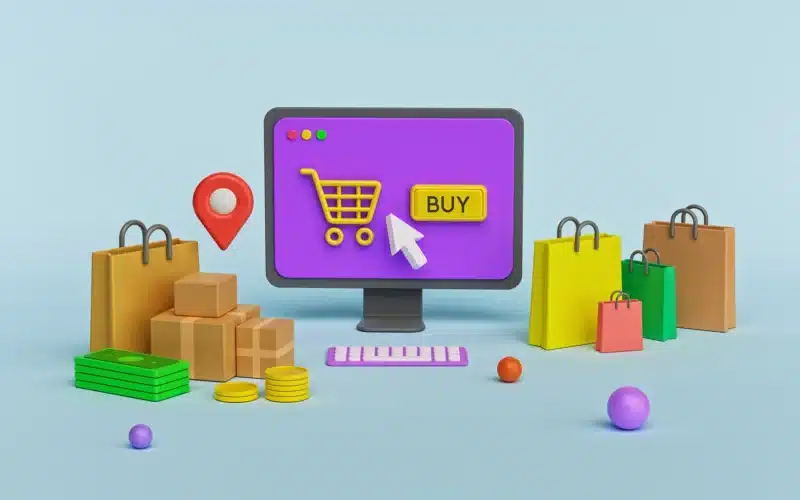Buying things from the comfort of your home, office, or at any spot is now easier, better, and stress-free with a functional order to cash process flow. All you have to do is head on to Amazon or the e-site you wish to buy from, place an order, fill in the necessary information, and wait for your delivery within record time. The order to cash process, SAP ERP, and other software make this relatively easy. The order to cash process flow does not just ensure a customer gets what he wants on time; it also improves a business’s effectiveness from recording transactions to making account entries and notifying the office to restock inventories. Hey, the order to cash flow is something you’d love to understand how it functions. And this is an overview of the OTC process and how it works.
What Is the Order to Cash Process?
The order-to-cash process is the flow of activities from when a customer orders a product or service till the delivery of the items. It includes all the steps from the time a customer places an order for goods or services until the customer gets the item and the business also receives payment. Generally, it details every activity from sales orders to customer payments, even down to the collection of the item and how your business manages the transaction. That is because the order to cash cycle involves how your company receives, processes, manages, and fulfills customer orders.
This may include issuing invoices, shipping, collecting payment, and reporting on the entire transaction. Additionally, there are limits to the impacts of OTC on businesses. This is because it has a big influence on business as well as strengthens the relationship between you and your customer if maximized. Any inefficiencies between when a customer orders your product or service to the time of delivery will eventually lead to a negative result for your business.
Reasons Why Businesses Maximize the Order to Cash Process Flow
The order to cash process flow is one key financial inventory that every online business must integrate into its management system. Aside from the fact that it is a system designed to function with full accuracy, it is super fast, stores data, and transfers records instantly, among other benefits. Generally, goods are subsequently shipped when the order is registered in the sales ledger. It records every transaction into the right accounting entries. Finally, in the supply chain, automatic re-ordering via the ERP system is triggered to guarantee inventory is refilled for future sales.
Complete Guide on Order to Cash Process Flow
The following are the step-by-step guides on how an effective order to cash process flow should be.
1. Receiving & Managing Orders
Once a customer orders goods or services from your organization, the cash-to-order process cycle or flows immediately begins. It’s critical to have a good order management system (OMS) in place to avoid delays in submitting customers’ orders. You know, re-entering an order may not be something a customer will like to face often. Generally, customers may place their orders through e-commerce, direct sales, or other possible means. Once this is done, the order processing system checks inventories after the order is submitted to ensure that the products can be shipped to the customer’s designated location.
The order management system is designed to send notifications to you or your team immediately after an order is placed. It is ideal to figure these things out early. Why? This is because your business may have a lot of problems if your order management system isn’t working properly. Imagine a customer re-entering an order often, calling about shipment delays, or receiving the wrong product. Arrh! No one wants that. To avoid this, your OMS estimates a delivery timeframe immediately after verifying customers’ information.
#2. Manage Credit and Payment
Depending on the payment method a customer chooses, and also to see if the order was approved on existing credit terms, the customer’s credit facility will be checked. Right before that, most B2B takes place on credit. With that, there is enough time for an invoice to be created, received, and paid without delaying order fulfillment. Carefully assessing credit in time, greatly reduces payment risks. The OMS helps out with this step. So when a consumer places an order, the system will send the payment via an approval process automatically. If and when payment is approved, the system will accept or deny it and then proceed to fulfillment. However, this is for existing customers. New customers will have to accept or deny the transaction.
#3. Prepare For Shipping
At this stage of the cash-to-order process, preparation is made to ship a customer’s order, whether it is goods or services. If you have an effective system, orders will be directly linked to your ordering software. This will mean those in charge of the warehouse where goods are stored will receive the order information and get them ready just the way the customer demands. You need to ensure you dispatched the goods on time to avoid delay or a customer calling to inform you they didn’t get the product as promised. Irrespective of the method you use, ensure your package is prepared for shipment using your fulfillment data. This will ensure the correct item is sent to the customer’s location.
#4. Invoice Generation And Account Receivable
Depending on the payment system you adopt, the accounts receivable procedure begins when a sale is made and products are dispatched. If you adopt a system that allows customers to pay once an order is made, you won’t do this. But if your customers complete the order payment immediately after delivery is done, you need to establish a functional system that will generate an invoice, deliver it, keep track of it, and also reconcile it to your ledger.
A client invoice is a document that lists the things that were purchased as well as the price at which they were sold to the customer. An invoice will then include all pertinent information, such as the items purchased, payment information, order date, and mailing address. Invoicing is another crucial step in the order to cash process. Getting it wrong can turn a customer off. Imagine ordering goods worth $250 and getting a bill of $2500. Alarming right? You can get invoicing software to help you with sorting this out. One of the best ways to avoid discrepancies is by creating an invoice for every order placed.
#5. Receiving Your Payment
Your business’s accepted payment method should be clearly stated at the time of purchase and on the invoice too. When a customer places an order, a purchase order number is generated. A buy order number is a common tracking reference that ensures that each payment is properly linked to the appropriate order. Additionally, it is also used to monitor and offset payments.
Most of the time, customers pay online using bank transfers or multiple payment options, such as electronic funds transfers, credit, or debit card payments. While you can provide customers with the option of mailing a check or money order, this can cause delays. Mailing a check or money order is another means of payment in which customers submit payment and these are subsequently collected. You can get paid faster if you make it easier for your clients to pay online though.
Creating an easy and super fast payment system gives you an advantage. Therefore, set your order management and invoicing systems to automate this part of the cycle. Finally, get your accounts receivables staff to contact the clients if there is a problem with payment collection. Problems with payment include the following: delayed payment, complete nonpayment owing to an error that happened after invoicing, and so on. There are few cases of outstanding unpaid balances but these are either written off as bad debt or referred to a third-party collections agency.
#6. Data management And Analysis and Report
If your business will eventually scale through this process, you need to prioritize data reports and analysis. Make sure you include the SAP enterprise resource planning system in your order to cash process inventory for effective data management. The SAP enterprise resource planning system (ERP) helps you to collaborate across systems to identify stock levels, fill orders, and trigger reorders.
How Does it work?
A business order to cash process SAP enterprise resource planning system (ERP) is designed in such a way that when orders are completed, the invoicing system must accept a trigger to generate an invoice. The system then retrieves data about the order, checks the customer’s credit limits and agreed to payment terms, and then generates and delivers an invoice to the correct contact.
Additionally, to ensure that payments are reconciled against the correct order, the payment collecting mechanism must be linked back to the purchase ledger. What’s more, these steps are all automated into the order to cash process to boost efficiency and accuracy. You’ll also be able to ensure that you’re accurately filling and shipping orders on time for your consumers while also increasing your revenues.
Order to Cash Process SAP
The SAP Order to Cash process is a means of creating a sales order for a customer and fulfilling those orders via delivery. Although you get your cash in between the order and the delivery. Before a customer places an order, certain things must be in place. These include an automated data and record system, a sales area, a payment system, and so on.
SAP has a handy feature that replicates data from pre-sales documents to sales orders. With that, customers’ details are stored in the ERP inventory. What does this imply? It means there will be no need for a customer to re-enter the same information into the SAP ERP system each time they want to place an order. This in turn speeds up a company’s sales operations.
Stages in the Order to Cash Process SAP
Generally, there are four primary stages of activities that take place in a typical SAP order-to-cash process.
- Pre-sales activities
- Order Processing
- Shipping
- Billing
SAP OTC Process: Pre-sales Activities
Pre-sales activities occur before a sale transaction is completed. This makes it the first step in the SAP ERP process. The following procedures and documents are part of the SAP order to cash process pre-sales activities.
#1. Inquiry
The first step in the pre-sales activities is an inquiry. Here, a customer inquires about the product’s price and service. An inquiry number is generated once a customer submits an inquiry. Generally, VA11 is the transaction code used to create an inquiry. Even though the SAP process begins with an inquiry, this process has no impact on the general ledger accounts. Therefore, it generates no accounting entries. Inquiring about a product or service in the SAP inventory doesn’t bind the customer to place an order. However, the information can be saved as a document in SAP.
#2. Quotation
A quotation is a document that outlines a company’s offer to customers. It is more like a price quote. The quotation document includes products, prices, and other information such as colors, and sizes in the case of shoes. A customer can generate a product or service quotation even without having the inquiry reference number. Also, the transaction code VA21 generates a quotation.
#3. Create Contract
A contract is a written agreement between a corporation and a customer to provide products or services for a set period and under specific circumstances.
#4. Scheduling Agreement
A scheduling agreement is a legal agreement between a corporation and a customer to offer items or services with delivery amounts and dates. The SAP ERP automated system crosschecks the customer’s information and fixes a possible delivery date based on the provided information.
SAP OTC Process: Ordering Process
Under the ordering process, we have the sales order. The sales order comes into play immediately after a customer places an order for products or services.
#1. Sales Order
A sales order is a document that records a customer’s request for goods or services. If your company includes the inquiry and quotation steps, the sales order comes up next. The transaction code that generates a sales order is VA01. One key feature of the SAP order-to-cash system is that a sales order can be made without a quotation reference. Generally, the sales order document contains a wide range of information. These include the following;
- Pricing information
- Billing information: this includes terms of payment and risk management.
- Product and/or service information
- Delivery information: This includes the date and quantity of goods and or services.
- Information on the shipment. This includes the shipment route.
SAP OTC Process: Shipping
Shipping in the SAP order to cash process is all about the delivery of goods and or service to the customer’s address.
For delivery to take place, there is a need for the SAP outbound delivery document. The SAP outbound delivery document is a document that allows items to be shipped to a specific customer. This document is quite useful in carrying out the various activities in line with the shipment. The transaction code for shipment or delivery of the SAP ERP order to cash process is VL01. A typical outbound delivery document includes the following;
- Packing
- Picking and Confirmation. This is actually to verify a transfer order.
- Transportation and delivery (Shipment document)
- Post Goods Issue PGI
SAP OTC Process: Billing
Billing is the last stage of the pre-sale activities. It also involves the use of the billing document. A billing document serves as the foundation for creating client bills. Generally, there are two ways of billing and receiving payment from customers. The first is to send the invoice with the goods and services. This way, customers pay after receiving the goods. It is the most common way in the SAP order to cash process.
The second is to integrate a payment system before the delivery system. This way, people pay in advance, as soon as they place an order. The SAP ERP order to cash process makes it possible for invoice automation to automatically account for entries. As soon as the SAP ERP notes a customer’s payment, it debits the customer’s account, credit cash account, and credit tax. Additionally, the transaction code for billing is VF01. The billing document does the following;
- It creates invoices
- It also creates credit and debits memos.
- Cancel any billing papers that have already been prepared.
- It automatically posts to the G/L account with SAP integration
SAP OTC Process: In Between OTC Delivery & Billing Stage
Delivery and billing are both stages of the order to cash process. However, there is a key activity that takes place between the delivery and billing of a customer’s order. This is the post goods issue PGI.
What Is Post Goods Issue PGI?
When a customer places an order, they get the items at their doorstep. Ever wonder where the gods come from? Yeah, the warehouse. The post goods issue is the OTC stage in which goods are picked from the warehouse, packed, and dispatched to the customer’s specified shipping address. The staff at the warehouse are extremely careful not to mess up an order. Therefore, it makes proper good use of the information sent from the order placement. It also has accounting entries in which inventory is debited while the cost of goods sold is credited.
Benefits of the SAP ERP & Order Management to Cash Process
Using automation software for the order-to-cash process have lots of benefits. These include the following;
#1. It Saves Time
Ever thought more could be achieved and that in time too? Well, that is what SAP ERP and OM cash-to-order process automation tend to achieve. Imagine invoice generation, billing, accounting entries, mailing, and following up payment being done by humans and then compare it with an automation system that processes this instantly. Another way the SAP ERP and OM cash-to-order process automation saves time is by preventing re-entry. It automatically stores customers’ information. So an existing customer that wants to place another order already has their information in the system.
#2. It Simply Reposts and Auditing
The SAP ERP and OM cash to order automation process records and store all customers’ information and transaction. As a result, it is very easy to assess and analyze these records.
#3. It improves Cash Flow
Every business has one common goal: to increase cash inflow and profit. The SAP ERP and OM cash-to-order process automation in reducing time and increasing efficiency have one result. Cost-effectiveness and increases cash flow.
#4. It Reduces Costs
The cost that will arise from paying staff to manage order placement, sort orders, record transactions, and other activities will not rise. Imagine paying for handling phone orders, and the rest of the activities that take place in the order to cash process.
#5. Gain Real-Time Visibility
Generally, the SAP ERP and OM cash-to-order automation process is software that keeps track of transactions and also manages information. This gives rise to real-time visibility.
#6. It Results In Accuracy
The SAP ERP and OM cash-to-order process automation lead to improved accuracy in records. The system gives no room for errors of omission or commission, which are most common with human record keeping. Data simply moves from one stage of the order to the cash process with ease, speed, and accuracy.
#7. It Improves Customers’ Experience
The SAP ERP and OM cash-to-order automation process improve process uniformity, fulfillment reliability, brand perception, and payment simplicity, all of which promote customer relationships.
Maximizing the Order to Cash Process
Businesses that invest in their OTC process record great returns on their investment. Maximizing the process leads to efficiency and effectiveness. It saves time, greatly minimizes errors, and is cost-effective in the long run. Some businesses integrate technology such as SAP and order management, consultancy services, and financial to provide optimum results. Thus the integration of software such as the SAP ERP program is more effective than the use of paper and manual operation.
SAP Order To Cash Process And Order Management
Order management is an administrative process that is part of the SAP integration. Combining the order management and the SAP cash-to-order process results in a faster sales cycle, easier handling of items, and faster order processing.
Key Features of The Order management & SAP Order to Cash Process
The key feature of automation software is that it automates order processing and integrates data from many modules in a smooth manner. Additionally, it includes the customer master database, returns and refunds, billing information, shipping information, payment terms, payment conditions, and other information relevant.
What is O2C and P2P?
In general, the procedure a company uses when making purchases from suppliers is known as “Procure to Pay,” or P2P. Order to Cash, or O2C, is the process of getting payment for goods or services provided. It is the other side of the coin.
What is O2C life cycle?
The order-to-cash cycle, often known as O2C or OTC, describes how your company receives, handles, manages, and completes consumer orders. This entails managing each step of the transaction, from shipping the goods to collecting payment to generating invoices to reporting on the entire transaction.
What is P2P and O2C in SAP?
The business processes Order to Cash (O2C) and Procure to Pay (P2P), which complement one another, are executed almost exactly the same way. The entire client ordering and fulfillment process is covered by the O2C process, while the P2P function deals with a business’s procurement cycle.
What is KPI in order to cash?
Analyze the overall cost of the order to cash value stream or the overall cost of the separate processes that make up the value stream. Take a preliminary look at the cost of the process divided by revenue or another normalizer using the balanced set of KPIs to track.
What is P2P and P2R?
Determining whether to execute the entire Procure to Pay (P2P) process or a partial deployment, such as Procure to Receipt, is a decision that businesses frequently have to make (P2R).
What is R2R cycle in SAP?
Record to report (R2R) is the process of gathering, analyzing, and presenting precise financial data. R2R offers management and other stakeholders feedback on the organization’s performance from a strategic, financial, and operational standpoint.
How to audit O2C?
A standard O2C process includes taking customer orders, granting credit or authorizing them, filling orders, issuing invoices, and taking payments from customers. It also includes tracking receivables and reconciling them with bank records.
Conclusion
Incorporating ERP inventory such as the SAP order to cash process into your business management system is not just cost-effective but also efficient. Therefore, it is a business model every online business must adopt.
FAQs On Order To Cash Process
What is the order to payment cycle?
There are times that a business may offer discounts on some goods or services. When this happens, customer loves catching in on such offers by making payment while the order last. This is what the order to payment cycle or process flow is all about.
What is P2P?
P2P is an acronym for procure to Pay. It is a term used to describe the process a business will go through while making purchases from suppliers.
What is the significance of O2C to businesses?
Everyone loves anything that saves time and produces more results. This is one of the key significance of the order-to-cash process. If a business can sell its product quickly, there will be cash inflow. So the order to cash process makes a business effective and efficient.
Related Articles
- SAP ACCOUNTING: What is Sap Accounting? (+ Top 2023 Courses)
- Demand Planning Softwares: Top 2023 Picks & Best Practices
- Sales Order Automation Process Steps (+ Free Sales Order Form Template)
- How do Money Orders Work? (+How to Buy with Debit Cards
- ERP SYSTEM: Meaning, Examples, and Top 5 Picks
- Best 15 Free Accounting Software for Business Owners
- NET 30 PAYMENT TERMS: Meaning, Examples & Reasons Why You Should Use Them or Not






